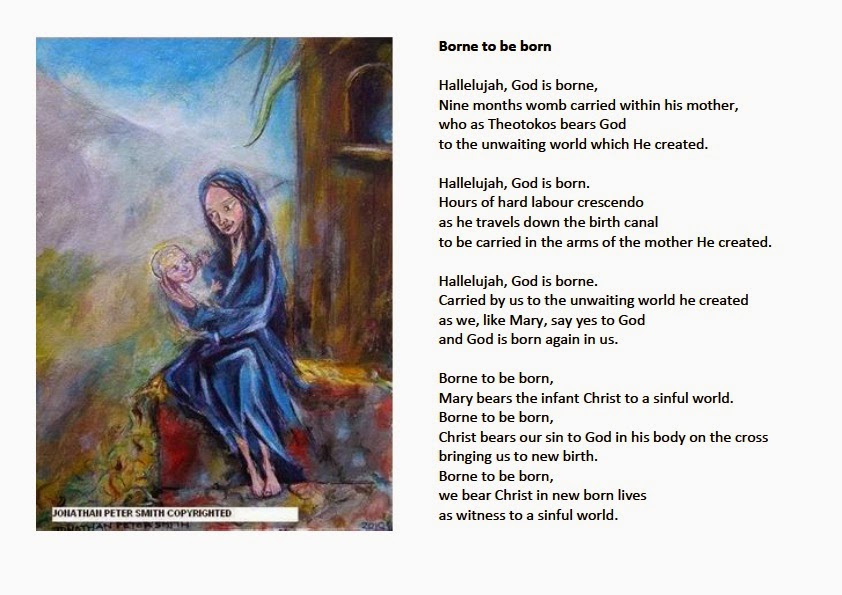'Borne to be born' handout with 'Mother and Child' by Jonathan Peter Smith - smithpeterjonathan@yahoo.co.uk
Ever since using a poem about
Mary by
Malcolm Guite while in
Nazareth with the
East London Three Faiths Forum, I have been reflecting on the first title given by the Church to Mary, ‘Theotokos,’ which means ‘God-bearer’.
Malcolm Guite says of Mary, ‘Mary has been given many titles down the ages and some Christians have disagreed with one another bitterly about her. But equally, in every age and every church she has been, for many Christians, a sign of hope and an inspiration. Her earliest ‘title’, agreed throughout the church in the first centuries of our faith, before the divisions of East and West, Catholic and Protestant, was Theotokos, which means God-Bearer. She is the prime God-Bearer, bearing for us in time the One who was begotten in eternity, and every Christian after her seeks to become in some small way a God-bearer, one whose ‘yes’ to God means that Christ is made alive and fruitful in the world through our flesh and our daily lives, is born and given to another.’
Mary bears or carries Jesus in her womb for nine months and is also borne or carried by her after his birth, as that is what mothers do with their new born children until they can crawl or walk. The idea that he is borne by her holds lots of potential for word play with the two meanings and spellings of the word. ‘Borne,’ as in carried, and ‘Born,’ as in giving birth. I’ve been trying to play with those words in writing a meditation on this theme which I’ll read to you later.
Once he becomes a man and can no longer be borne or carried himself, Jesus bears or carries us to God the Father by means of his sacrificial death on the cross. So, he is born(e) into the world in order to bear us to God.
In turn, we then bear him to others as he is born in each one of us as we open our lives to him and can then bear, carry or take him to others as our daily lives reveal aspects of his character and love to others. As
Teresa of Avila said:
‘Christ has no body but yours,
No hands, no feet on earth but yours,
Yours are the eyes with which he looks
Compassion on this world,
Yours are the feet with which he walks to do good,
Yours are the hands, with which he blesses all the world.
Yours are the hands, yours are the feet,
Yours are the eyes, you are his body.
Christ has no body now but yours,
No hands, no feet on earth but yours,
Yours are the eyes with which he looks
compassion on this world.
Christ has no body now on earth but yours.’
In this way, we bear him to others.
So, Christ is carried by Mary, both in her womb and in her arms, in order that he can then carry us to God by means of his death of the cross. Finally, we carry him to others by means of our daily life and witness.
Here are those thoughts expressed in my meditation:
Borne to be born
Hallelujah, God is borne,
Nine months womb carried within his mother,
who as Theotokos bears God
to the unwaiting world which He created.
Hallelujah, God is born.
Hours of hard labour crescendo
as he travels down the birth canal
to be carried in the arms of the mother He created.
Hallelujah, God is borne.
Carried by us to the unwaiting world he created
as we, like Mary, say yes to God
and God is born again in us.
Borne to be born,
Mary bears the infant Christ to a sinful world.
Borne to be born,
Christ bears our sin to God in his body on the cross
bringing us to new birth.
Borne to be born,
we bear Christ in new born lives
as witness to a sinful world.
Are you humbled by the thought that God was born(e) by a human mother? Are you conscious of having been borne by Jesus to God? How are you bearing Christ to others, as his hands, feet, eyes and body in the world today? Are these responses something for which you pray and for which you are thankful today?
------------------------------------------------------------------------------------------
Malcolm Guite -
Angels Unawares.











